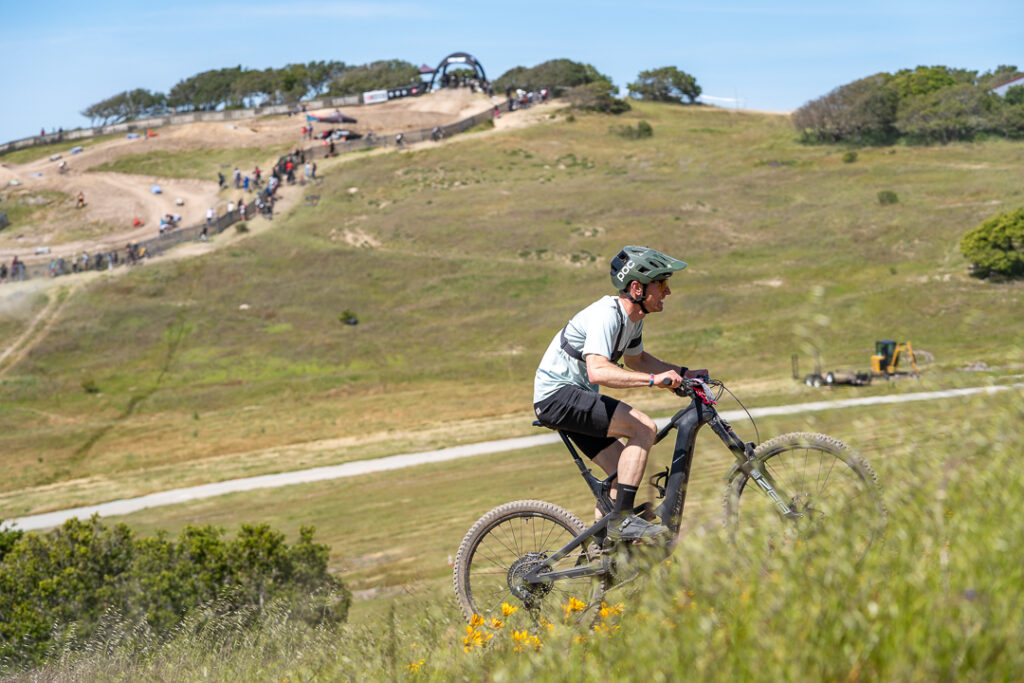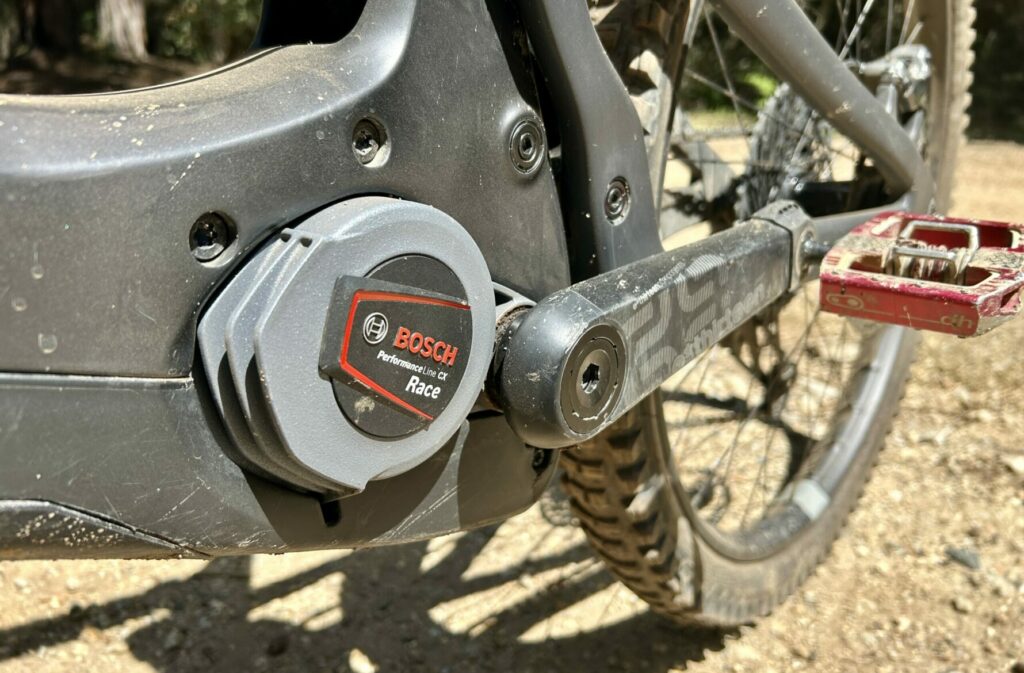If you build it, they will come … err, they will race. Right? E-bike racing is still in its infancy, especially in North America. Other than the Enduro World Series (EWS), e-mountain bike races are few and far between, and there isn’t a ton of consensus on what these events look like. On the other hand, the technology is much further along in the development process.
Enter the Bosch Performance Line CX Race drive unit. Bosch is betting that its limited edition motor can propel top athletes to victory in the EWS. Over the course of two separate trips out to California to ride the CX Race and talk to the folks at Bosch, I got some hands-on experience with this new drive unit.
While you might never compete in an e-MTB race, especially a European EWS, the Bosch CX Race is a notable entry into the e-MTB marketplace. It’s not for everyone, but if you want a motor that blows back your hair, this could be the ticket.
Bosch CX Race Specs
| Bosch Performance Line CX Race | Bosch Performance Line CX | |
| Max Torque | 85nm | 85nm |
| Wattage | 250w | 250w |
| Support Level | 400% | 340% |
| Extended Boost | Yes | Yes |
| Smart System App | Yes | Yes |
| Drive Unit Weight | 6.1lbs | 6.4lbs |
Right off the bat, you might be wondering what the fuss is about. Did Bosch just stencil “Race” onto a Performance Line CX drive unit and call it a day?
Many of the basic specs are similar between the new Race motor and the Performance unit — wattage, torque, app compatibility, and more. When you see them side by side, they are visibly different. The Race drive unit has a magnesium housing, which helped shave a third of a pound off of the drive unit weight. The real magic, however, is on the inside.
Bosch tuned the CX Race motor to make it extremely responsive while riding in the maximum assist setting — “Race” mode, unsurprisingly. Yes, it’s accessing the same 85nm of max torque as the Performance Line CX motor in “Turbo” mode, but it delivers that power more rapidly. As you can see, CX Race also offers up to 400% assist, compared to the 340% of the Performance Line CX drive unit. As I’ll explain in a minute, those differences are pretty noticeable on the trail.
The other thing about the CX Race drive unit is that it’s pretty rare. Only a few select brands will offer this motor on high-end builds.
Bosch CX Race Review
Backing up for a moment, I’ll clarify that when we’re talking Bosch-equipped e-MTBs, we’re strictly talking about full-power e-bikes. No matter whether it’s a Performance Line CX or a CX Race drive unit, it’s going to be noticeably more powerful than a lightweight e-bike, such as the Specialized SL line.
One more caveat: When we’re talking about CX Race, we’re talking about how it behaves in full-power “Race” mode. This drive unit also offers modes like e-MTB, Tour, and Eco, which are essentially the same as what you get in a Performance Line CX drive unit.
Once I got familiar with how it responded to my input, I was able to time my pedal strokes to pop the bike off of little trail obstacles using the Extended Boost. It is as fun as it sounds…
That said, side-by-side with the Performance Line CX drive unit, the CX Race has a noticeably different personality.
The biggest differentiator is how the CX Race accelerates out of slow corners, or into the base of the steep hill. This drive unit turns on the fire hose immediately when you ask for power. It is easily the snappiest, most aggressive electric assist I’ve ridden. Once you get it up to speed after an abrupt acceleration, it starts to feel more familiar. Going back to the specs, this makes sense, given that it runs the same maximum torque and wattage as a Performance Line CX, and of course, they are both Class I e-bike motors.
Along with the CX Race’s remarkably responsive personality, its Extended Boost capability also set it apart from the Performance Line CX drive unit. Both motors offer this feature — it is essentially a little extra electric assist after you stop pedaling. This boost is far more dramatic on the CX Race and actually takes a bit of getting used to. However, once I got familiar with how it responded to my input, I was able to time my pedal strokes to pop the bike off of little trail obstacles using the Extended Boost. It is as fun as it sounds…

Racing On a Bosch CX Race
It seemed appropriate to actually put on a number plate and see what the CX Race could do, right? At Sea Otter Classic, Bosch set me up with a Crestline RS 75/50 EEB, one of the few bikes equipped with a CX Race drive unit. I hopped into the e-MTB race to see what it could do.
Before I get into that, let me say that the Sea Otter e-MTB race is kind of a strange beast. It’s held on an Olympic-style cross-country course, a short loop with only one marginally technical rock garden, lots of weird grassy corners, and short, punchy climbs. An EWS race course, this is not.
In sections of the course that demanded pure power, the CX Race didn’t hold me back one bit. I couldn’t keep up with Swiss champion Joris Ryf, who blasted off of the start, never to be seen again, but I attribute that more to my lack of warm-up, middling fitness, non-aerodynamic tee-shirt, dehydration, and other excuses that I won’t bother detailing.
The course had one particularly nasty climb that came out of a sharp 90-degree corner after a fast downhill. This is where the CX Race’s immediate, raw power delivery really shined. It’s easy to imagine how it would come in handy on a track with multiple abrupt transitions from down to up.

Although I’d ridden this Crestline bike quite extensively prior to the race, I found that I had to adapt my riding style to the course’s awkward 180-degree corners. Between the CX Race motor’s aggressive power delivery and its Extended Boost, I had to be careful not to over-ride the course and end up off in the poison oak bushes.
At first, I tried switch the mode down to e-MTB prior to corners like that. De-tuning the motor this way helped mellow out the response as I pedaled into and out of corners. But when I was on the gas, it was tough to remember this adjustment lap after lap.
Instead, I altered my riding style while cornering in Race mode. Having a background in cyclocross racing, I’m temped to sprint out of corners, exacerbating the “whiskey throttle” effect on an e-MTB. After making that mistake on a couple laps, I started using the corners to recover, letting the drive unit do the work by soft-pedaling into the next straightaway. This afforded me nearly all of the exit speed I could ask for with less effort and more control.
Putting the CX Motor through its paces in a hectic race scenario reinforced to me how this drive unit can offer some impressive power, and it also showed me how it helps to familiarize yourself with the motor’s nuances and adapt your riding style to suit it.
It also was a good test of battery life. Racing for about an hour, almost entirely in Race mode, I drained the Crestline’s 750wh battery from 80% to 29%. Honestly, I expected the drive unit to draw more than that.
In a more realistic riding scenario, I did two rides on the Crestline in a single day, prior to Sea Otter. We started with a stout ride at the famous “Campus Trails” in Santa Cruz, California. That ride clocked in at 2:30, 24 miles, and 4,300 feet of climbing. Then, we got in a twilight ride on the Sea Otter enduro course, where I milked the battery until the very end. It died on the last climb back to the venue, but I rode another 1:25 over 14 miles with 2,000 feet of climbing. So, using the Race mode sparingly, a 150-ish-pound guy like myself got about four hours of riding out of that 750wh battery.
Who Needs a Bosch CX Race Motor?
It begs the question: If you aren’t doing any e-MTB races, do you need a Race motor?
Do people need Porsche GT3s or Ducati Panigale motorcycles or any of the Tour de France-caliber bikes you see out on the road? These questions seek a rational answer to an irrational question. At this level of performance it isn’t about practicality, it’s about pushing the boundaries of technology.
Hypothetically, if you were planning to race EWS or other events, a Bosch CX Race drive unit would be an advantage. But keep in mind that we Americans can buy Class I e-bikes governed to 20mph, while the EWS is governed by EU rules that cap pedelec e-bike speeds at 25kph (approximately 15mph). Sorry, now we are off in the weeds.
Do people need Porsche GT3s or Ducati Panigale motorcycles or any of the Tour de France-caliber bikes you see out on the road? These questions seek a rational answer to an irrational question.
Setting aside actual racing, there are some situations where a CX Race motor would be fantastic. In places where terrain has extreme undulations or tricky sand sections that require more electric assist, this drive unit would be awesome. Plus, there are likely some riders who simply want this powerful response from their e-bike’s drive unit, provided they can adapt their riding styles to make it work for them.
Put another way, if you’re in the market for a very high-end e-MTB, and it comes with a CX Race drive unit, that’s a very nice cherry on top. And anyway, if the tune is a bit too aggressive for your tastes, you can use the Smart System App to adjust the motor settings.
Most of us will likely end up with a Performance Line CX drive unit, if we get a Bosch bike. Given that the CX Race is essentially a heavily modified version of that, it’s confirmation that this is a solid motor platform.
